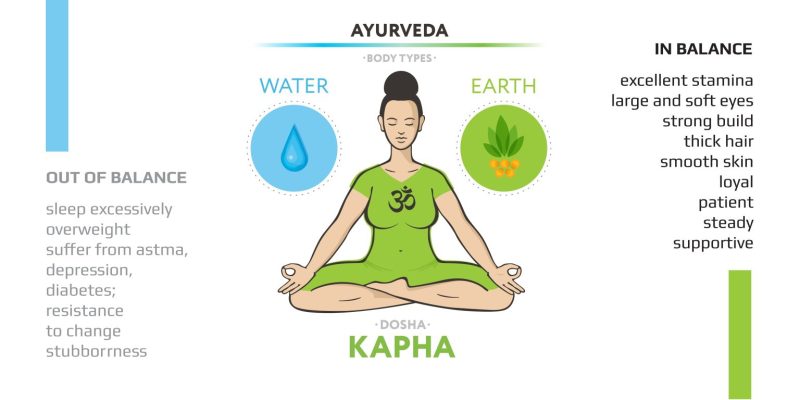Blogs
Unlocking the Secrets of Kapha Dosha: A Comprehensive Guide
INTRODUCTION TO KAPHA DOSHA
Kapha is one of the primary doshas in Ayurveda. It represents the water and earth elements. Kapha’s features include lubrication, coldness, and heaviness, all of which provide the body with stability. Kapha’s key role is to lubricate various tissues while also ensuring healthy immunity and mental stability. Without Kapha’s lubrication, the body becomes stiff and unyielding during movement.

When Kapha is balanced, it gives structure and stability, but Kapha excess can cause undesirable mucous, lethargy, and emotional stagnation.
Characteristics of Kapha people
An Ayurvedic practitioner can best assess if your body’s constitution is Kapha-dominant or not. However, there are several typical features that are frequently noticed in a Kapha constitution. Let’s look at these aspects.
- Kapha individuals have a robust and solid frame, and they may acquire weight quickly.
- Their hair is silky and well-hydrated as a result of the regulated Kapha.
- Kapha people are known for their stamina and endurance, and they excel in sports.
- They are naturally composed and quiet.
- Kapha persons may be able to deal with stress successfully because of their calm and tranquil attitude.
- Individuals who have a Kapha imbalance struggle to let go of grudges and may even grow complacent.
- Kapha people prefer structure and swear by routines.
- They often have a slower metabolic rate, which can contribute to weight gain.
- Kapha persons are often compassionate and loving towards others.
How to Balance Kapha Dosha.
If the Kapha dosha becomes excessive or unbalanced, the person may experience mental and physical stagnation. To counteract Kapaha’s traits of being heavy, chilly, and slow, they should incorporate behaviours that are the polar opposite. For example, eating lighter, dry meals with spices may help balance the excess Kapaha. Spending time in the sun, exercising frequently, and adhering to a sleep schedule may also help balance the Kapha. They can also do pranayama and yoga, which may help them overcome mental and emotional blocks.
KAPHA BODY TYPE DETAILS:
Physical features of Kapha individuals.
Individuals with a controlling Kapha dosha or a Kapha constitution typically have a substantial and large physique, which represents the earth element. They are powerful and durable, with exceptional fitness, stamina, and endurance. Because to the presence of lubricant in Kapha, Kapha people’s skin is moisturised and smooth, with a bright complexion. Their eyes are generally larger than their face. The bones are also strong, having a high density. And Kapha individuals’ nails are robust and do not crack or break readily. Their teeth are normally aligned. If the Kapha is out of balance, an individual may have slow and sluggish movement.
Psychological and emotional traits
Kapha people’s mental and emotional qualities mirror the earth and water elements. They are calm and stable, having a high level of emotional stability. Kapha people are naturally gifted with qualities such as empathy and listening skills. They are frequently sluggish learners yet have excellent long-term memory, prefer comfortable surroundings and enjoy spending time in warm settings. They have a propensity to be sluggish in their decision-making processes; they want to consider all choices. Individuals with an unbalanced Kapha may be complacent and indolent, as well as possessive in their relationships.
Kapha people can pursue careers in athletics, the military, or any other vocation that needs physical prowess. Furthermore, because of their compassionate and caring nature, Kapaha types may pursue humanitarian, social service, or health care careers.
Common diseases among Kapha people
Kapha dosha, which is chilly, heavy, and moisturising (watery), can impact the same components found in the body. Some of the most prevalent health issues found among Kapha people are as follows:
- Obesity
- Drowsiness
- Lethargy
- Sinusitis
- Chest congestion
- Cold and cough.
- Water Retention
- High Cholesterol and Depression
- Sleep Disorder
- Salivation
- Digestive issue (low digestive fire)
- Loss of strength
If you are dealing with any of the above health conditions or want to know more about your dosha type, book an appointment with an expert Ayurvedic Doctor of KAIRALI AYURVEDIC CENTRE. CALL US ON +91-8826513700
Diet and lifestyle of Kapha people
Excessive Kapha levels in the body can be harmful to one’s health and well-being. As a result, one must work to balance Kapha through food and lifestyle.
Go on an ayurvedic cleanse: Ayurvedic detox, also known as panchakarma, is an excellent approach to eliminate any toxins, extra water, or nasty mucus that may be interfering with the body’s overall health and well-being. The five processes of panchakarma can successfully revive and renew the body.
Maintain a healthy bodyweight: Being prone to weight gain or morbid obesity, Kapha people should watch what they eat and exercise often to boost circulation, metabolism, and warmth. Staying active is essential for Kapah people to overcome apathy and tiredness.
Consume lighter dishes with a dry texture: Season nutritious grains and leafy greens with spices like ginger, black pepper, and cayenne. Avoid cold and heavy dairy products like frozen yoghurt, processed cheese, and ice cream, which can irritate Kapha even worse.
Yoga & Pranayama Yoga and meditation may help to balance the sluggishness of Kapha. Yoga techniques such as Surya Namaskar (Sun Salutation), Warrior Pose (Virabhadrasana), Bhastrika, and Kapal Bhati may also be beneficial. Breathing practices can provide the body with the vigour and vitality that a Kapha person need.
TIPS FOR BALANCING KAPHA DOSHA
Foods to Eat/The Kapha Diet
A Kapha diet should consist of foods that are dry, warm, spicy, light in texture, and readily digested. A Kapha diet should include vegetables like asparagus, kale, broccoli, cauliflower, garlic, ginger, aubergine, celery, lettuce, spinach, tomatoes, sprouts, and okra. They may ingest grains such as quinoa, millet, maize, wheat, and muesli. They may also ingest fruits including apples, cranberries, raspberries, dried figs, tamarind, pomegranate, and cherries. If the folks eat meat, they should switch to lean meats like chicken or fish.
Activities and Exercises for Kapha People
Most Kapha folks must follow a 30-minute workout plan. It is also critical to maintain consistency in your training programme. This will allow you to boost your energy, eliminate lethargy, and maintain your mind and body healthy. Here are a few exercises you might include:
- Cardiovascular workouts.
- Strength training with yoga (e.g., Surya Namaskar, Ashtanga Yoga).
- Activities include hiking, swimming, team sports, Pilates, and interval training.
Please keep in mind that the workouts listed above should only be performed by people who are in good physical health. If you have a long-standing or underlying health issue, see your doctor before beginning any new fitness routine.
Herbs and supplements to consume
Ayurveda recommends using Tulsi (holy basil), turmeric, black pepper, triphala (Amalaki, Haritaki, and Bibhitaki), cinnamon, cloves, fenugreek, cumin, coriander, and other ingredients to balance an excess of Kapha dosha.
Consult an Ayurvedic practitioner to learn more about how to include the aforementioned herbs and spices into your daily regimen, as well as the quality.

